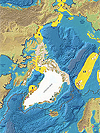A new report identifies 13 areas of the Arctic most vulnerable to the effects of climate change and calls for their protection as sea ice melts and industrial activity moves into newly accessible areas. Some of the areas identified in the report, which was published by the Natural Resources Defense Council (NRDC) and the International Union for the Conservation of Nature (IUCN), include the Bering Strait; the Chukchi Beaufort Coast in Alaska; St. Lawrence Island; the Beaufort Coast/Cape Bathurst in Canada; the Great Siberian Polynya, located off Norway and the Russian Federation; Russia’s Novaya Zemlya Island; and the High Arctic islands and shelf. Lisa Speer, director of the NRDC’s International Oceans Program, said there is a small window of opportunity to plan for industrial development in what she called the world’s “last ocean frontier” as numerous nations plan offshore oil development, expanded fishing, and new shipping routes.
Vulnerable Arctic Areas Need Protection as Region Warms, Report Says
More From E360
-
Cities
‘Sponge City’: How Copenhagen Is Adapting to a Wetter Future
-
INTERVIEW
On Controlling Fire, New Lessons from a Deep Indigenous Past
-
Solutions
Paying the People: Liberia’s Novel Plan to Save Its Forests
-
OPINION
Forest Service Plan Threatens the Heart of an Alaskan Wilderness
-
INTERVIEW
Pakistan’s Solar Revolution Is Bringing Power to the People
-
Food & Agriculture
In Uganda, Deadly Landslides Force an Agricultural Reckoning
-
Energy
Why U.S. Geothermal May Advance, Despite Political Headwinds
-
Food & Agriculture
In War Zones, a Race to Save Key Seeds Needed to Feed the World
-
Climate
Lightning Strikes the Arctic: What Will It Mean for the Far North?
-
RIVERS
A Win for Farmers and Tribes Brings New Hope to the Klamath
-
Solutions
Deconstructing Buildings: The Quest for New Life for Old Wood
-
NATURAL DEFENSES
How Restored Wetlands Can Protect Europe from Russian Invasion
